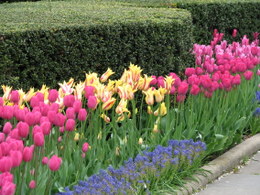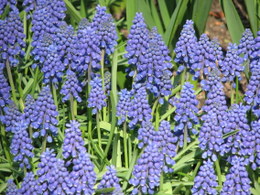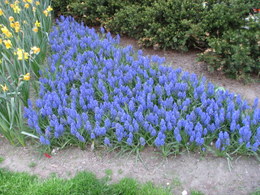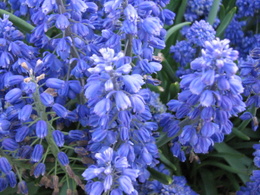Muscari Growing Guide
Muscari (Muscari armeniacum), also called Grape Hyacinth is a perennial early to mid-spring blooming bulb that is native to southeastern Europe. Their is no close relationship between the two. Muscari is hardy in USDA Zones 4 to 8 and will do well in full sun to part sun.
They bloom in the early spring, producing stems with clusters of elongated grape-like flowers. They reach an average height of 6 to 9-inches and
spread 4 to 6-inches. Common colors are blue, white and pink.
Muscari are deer and rodent resistant. They are often planted in large mass plantings of 50 or more bulbs, or flower beds in front of early spring blooming daffodils and tulips.
When purchasing your bulbs look for the largest bulbs, which will have the most energy stored up. Reject any bulbs that are small or shriveled up.
Soil Preparation
Plant your bulbs in full sun to part sun in a nice loose well-drained garden soil. They will do best in a slightly acid soil with a pH range of 6.0 to 7.0. The bulbs may rot if the soil is too wet.
When to Plant
Muscari should be planted in the fall just after the first hard frost, but before the ground freezes. Muscari need some time before the ground freezes for them to grow some roots.
Planting Muscari
Plant the muscari bulbs 3-inches apart and 3-inches deep, in large groups of 25 to 50-bulbs. Spread the bulbs out over the planting area to get an idea of how the planting may look and if you need more bulbs to get the look that you want.
To calculate how many muscari bulbs will be needed, you can plant at the rate of 16-bulbs per square foot.
A planting tool known as a dibble is useful for poking the many holes in the planting bed. Also useful is a garden auger that you attach to a corded or a cordless drill. An auger will quickly drill the many holes needed to get the muscari planted. It is important to mark the auger with tape or paint to indicate the proper planting depth. It is easy to get carried away and make the holes too deep.
If you are not sure which end of the bulb goes in the bottom of the hole, look for the flattest end, which will be the bottom of the bulb.
After planting water daily, tapering off as the muscari roots grow and get established. Once the ground is frozen you can forget them.
Watering and Care
They are low maintenance and easy to care for. All you need to do is add a layer of mulch to help retain moisture and keep out competing weeds. Your bulbs should get an inch of water each week during their growing and blooming season and during dry spells give some water to keep the soil moist.
They usually do not need any fertilizer, but a light side dressing of low nitrogen slow release 3-5-3 organic fertilizer such as Espoma Bulb Tone can be applied. Following the directions, apply when planting and after they have finished blooming.
After the flowers have faded it is a good practice to deadhead the dried-up blooms. This will stop seeds from forming and will put more energy into the bulb to make more flowers for next year.
Muscari like other spring flowering bulbs use their leaves to make enough energy to be stored in the bulb to produce flowers for next spring. Let the foliage grow until it yellows. If the muscari were planted in a lawn, do not mow until the foliage yellows. The grass will be very tall when the leaves yellow. Use a grass catcher when you mow to make the planting area look neat.
After a few years the blooms decrease and the bulbs can be dug up and discarded. The flower bed can then be used for some summer annuals.
Diseases and Pests
Muscari have no serious insect or disease problems.
Popular Varieties
Muscari armeniacum is the most common variety. Other varieties are Muscari azureum, Muscari botryoides, Muscari comosum and Muscari latifolium.
Sources: Bluestone Perennials, Breck’s, White Flower Farm.
Garden Spikes newsletters give you timely information once or twice a month. Subscribe Free to the Garden Times newsletter below.
Your email address will only be used to send you a newsletter and will never be sold. You can unsubscribe at any time.




